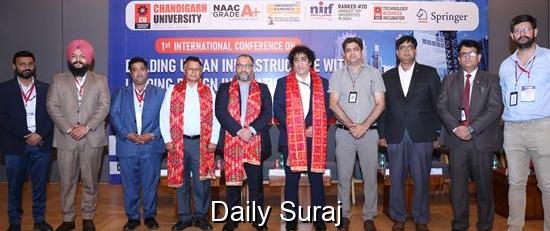Improved Road Infrastructure Driving India’s Economic Growth: CRRI
- Punjab
- 30 May,2025

Mohali (Punjab) : “Road transportation in India has been completely revolutionised over the past decade, thanks to world-class infrastructure development. This drastic improvement in logistics is fuelling significant growth across industries nationwide and will play a crucial role in making India a developed country,” said Dr Vinod Karar, Chief Scientist, Central Road Research Institute (CRRI) New Delhi, at the International Conference on “Building Urban Infrastructure with Leading Design Innovations (BUILD-2025)” organised at the Chandigarh University at its campus.
“In the past decade, new four- and six-lane highways have been constructed even in challenging hilly regions. Even aircrafts can land on some these highways. The road network now is so good that the transportation time and the ferrying of goods has become very easy. New bridges have also transformed connectivity — with roads on the first level and metro lines running just beside them, revolutionizing urban transport. With such robust infrastructure in place, industries are poised to grow rapidly, as improved transportation logistics play a crucial role in India’s economic development. This good infrastructure will play a crucial role in making India a developed nation because unless you have good infrastructure, no foreign country will invest in a country,” said Dr Karar while speaking on the India’s infrastructure development in past 10 years to realise the vision of a Viksit Bharat by 2047.
During a session on Trends in Road & Transportation Engineering Technologies in India, Dr Karar further said,”India is undergoing a transformative shift in road and transport engineering, spearheaded by the CRRI and supported by key institutions such as the Indian Roads Congress and the Ministry of Transport.
This evolution is marked by innovations including sunlight-redirection technologies, the use of indigenous materials like steel slag, and the deployment of advanced driving simulators for Special Purpose Government (SPG) driver training.
These efforts are fostering self-reliance in infrastructure research and development. Additionally, research into traffic idling losses highlights the growing emphasis on data-driven, sustainable transport solutions tailored to India’s complex urban landscape,” he added while speaking on the topic “Trends in road and transportation engineering technologies in India”.
Dr Karar said the future of civil engineering in India is evolving rapidly. For example, bridge construction is shifting towards prefabricated structures, allowing for much faster project implementation.
“Alongside this, there's a growing use of advanced materials such as steel, fibers, special glass coatings, and sustainable technologies. Significant research has been carried out to partially replace bitumen—a petroleum byproduct—with biomaterials, achieving up to 30–40% substitution. With continued innovation, we’re now able to reuse concrete and debris waste using special rejuvenators, making infrastructure development both faster and more environmentally responsible. Using steel aggregates, we have successfully built around 12 km of roads in India. These roads can handle heavy traffic on one side, and the process also results in significant cost savings. Additionally, by using steel aggregates, we reduce the reliance on natural aggregates, making the technology more sustainable. Currently, we are also laying approximately 10 km of road in the USA using this technology, which demonstrates its advanced level and international adoption. This technology has been praised by the Prime Minister, who is also the President of CSIR,” he added.
Jointly organised by University Centre for Research and Development and the Department of Civil Engineering, Chandigarh University, this Conference provided a platform for researchers from academia and industries to explore and share the advancements in different kinds of materials in civil engineering, green building technologies, development of sustainable building materials, implementation of energy-efficient designs and innovative construction materials offering enhanced performance and durability while minimizing environmental impact.
Speakers from leading universities of India and abroad, eminent scholars and subject experts from several sectors who shared their expertise during the Conference included Dr Chandni Thakur, Postdoctoral Researcher, at the School of Geography, Earth and Environmental Sciences, University of Birmingham, United Kingdom, Dr. Aurobindo Ogra, Senior Lecturer, Department of Urban and Regional Planning, Faculty of Engineering and the Built Environment, University of Johannesburg, Gauteng, South Africa, Dr Ravi Kumar Sharma, Professor, Department of Materials Science and Engineering, NIT Hamirpur, Himachal Pradesh, Rahul Kumar, Assistant Manager, L&T Construction, Dr. Ajanta Goswami, Associate Professor Department of Earth Sciences and Joint Faculty Centre of Excellence in Disaster Mitigation and Management (CoEDMM) at Indian Institute of Technology, Roorkee and Dr Avinash Bhardwaj, Design Engineer at Gabion Technologies.
More than 450 research papers were submitted for the conference by students, faculty members, academicians and researchers, out of which about 150 papers were selected. These research papers were from students, researchers, academicians and faculty members from NITs, IITs and top universities across the country and internationally.
Speaking on “Modelling of hydroclimatic variability due to El Nino events over India”, Dr Chandni Thakur, Postdoctoral Researcher, at the School of Geography, Earth and Environmental Sciences, University of Birmingham, United Kingdom said, ““El Nino event is the abnormal increase in the temperature of sea surface over the Pacific Ocean and due to these events occure like reduction in rainfall, further lead to insecurities of food and energy sectors. In recent years, there has been a noticeable increase in flooding and other extreme meteorological events. To ensure long-term sustainability, it is essential to develop infrastructure that is resilient to these challenges. Civil engineers must take such environmental factors into account when designing and constructing urban infrastructure or any civil engineering projects. From an infrastructure planning perspective, it is crucial to anticipate and prepare for these events, as they pose serious risks not only to human life but also to the infrastructure. Proactive, forward-thinking planning is key to mitigating the impact of future extreme weather events,”.
Speaking on the topic of “Smart Cities and Urban Planning”, Dr Aurobindo Ogra, Senior Lecturer, Department of Urban and Regional Planning, Faculty of Engineering and the Built Environment, University of Johannesburg, Gauteng, South Africa and Indo-African Urbanization, Industrialization & Transformation, Group Lead said, “It’s really heartening that India is now a global economic power. It is truly encouraging to see India emerge as a global economic powerhouse. With rapid urbanisation, urban centres are increasingly becoming the focal points of economic activity. Over the past few years, India has made significant strides in infrastructure development, with large-scale progress and strong synergy across multiple sectors. There is tremendous potential for technology integration, and India’s experience can offer valuable insights to the global community. India is firmly on track to realise the vision of a 'Viksit Bharat' by 2047. This is evident in the government’s focused approach—especially in infrastructure and highway development—where progress is visible from the national to the local level. We are seeing frequent inaugurations of completed projects featuring cutting-edge, state-of-the-art technology.
“Studies consistently show a direct link between infrastructure development and increased investment. As India moves steadily toward this transformation, it’s crucial to ensure that the cost of running cities remains both well-managed and sustainable,” he added.
#IndiaInfrastructure #RoadDevelopment #EconomicGrowth #CRRI #Bharatmala #TransportRevolution #HighwayDevelopment #SmartInfrastructure #ConnectivityBoostPosted By:
 Daily Suraj Bureau
Daily Suraj Bureau

Leave a Reply